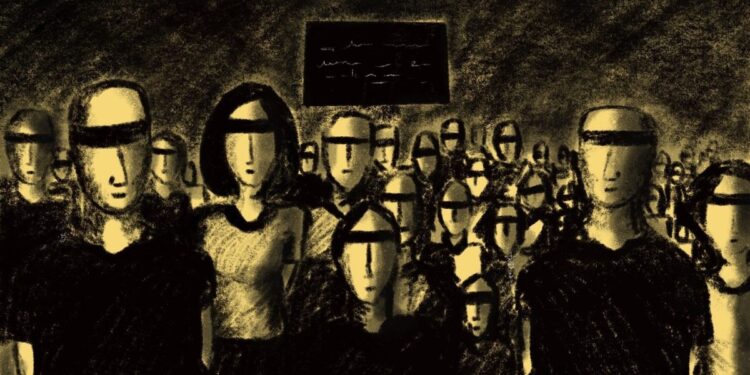Three separate cow slaughter-related hate crimes this week — the brutal assault of an elderly Muslim man on a train in Kalyan, the lynching of a Muslim migrant labourer in Haryana and the shooting of a Hindu student “mistaken” for a Muslim cattle smuggler near Faridabad – reiterate that the problem we are facing is not a breakdown of law and order, but the adoption of an entirely discriminatory new imagination of law and order.
In one of the cases, an assault of an elderly Muslim man on a train in Kalyan by three Hindu men who accused him of carrying beef, it is telling that the shaken victim did not initially seek to report the incident to the police. In a state where a serving railway protection force constable, Chetan Kumar, used his service gun to kill his own supervisor and three Muslim passengers on a train, just last year, this mistrust of the railway police is not unfounded. The accused in this latest assault were themselves on their way to Mumbai to take a police entrance exam. In multiple other lynchings of Muslim men across the country, including the brutal case of Nasser and Junaid in Nuh, the police have been accused of refusing to protect badly injured victims from the mobs. In the case of Aryan Mishra, the Hindu student “mistaken” for a cattle smuggler, a self styled “cow protection” militia, chased him in a car for 50km before shooting him dead. The group was apparently operating openly in the area, acting on a tip off, with no signs of being restricted or curtailed in any way by the police.
Police forces participating in communal and caste violence in the sub-continent and colluding with dominant groups is not a new phenomenon. The role played by the state controlled police forces in the 1946-48 partition riots on both sides of the border is well documented. This has continued post independence. In the 1987 Hashimpura massacre, for example, 42 Muslim men were rounded up by constables of the Provincial Armed Constabulary and summarily executed. 16 PAC men were convicted of this crime in 2018. Caste atrocities in Bihar the 1990s also often involved accusations of similar collusion between powerful non state militias like the Ranvir Sena and the police forces. And the general selectivity of police action in pogroms, including the anti Sikh pogrom in Delhi in 1984 and in Gujarat in 2002 is also well documented.
But what we are seeing today differs from these instances in a few critical ways.
First, it is not limited to or sparked by an outbreak of riots on the ground. There is no breakdown of law and order under the cover of which such massacres are carried out. They are ongoing in an everyday sense and this means, worryingly, that they are seen as the new normal. This is increasingly reflected in the media framing of these incidents. In the Aryan Mishra case, the media has predominantly focussed on the aspect of mistaken identity and not on the fact that an armed militia was operating with impunity in the area, and in the other two, the media has focussed on the allegation of consuming beef.
Second, the non-state militias committing violence do not mirror the spontaneous groups formed and disbanded during riots. These militias are organised, operate continuously and are vested with a certain amount of on-ground legitimacy, through the enactment of laws that target what these groups claim to be combatting – usually cow slaughter or inter-faith marriages. This is clear from how common it is for members of such groups to upload videos of violence on social media, completely unafraid that such videos will be used as evidence against them.
Third, the lines between the police and these groups are often blurred, as is evidenced by the fact that in the cases where these groups do not kill the people accused of cow slaughter or “love jihad”, the injured victims are handed over to the police, who then launch prosecutions. In the public imagination at least, the police and these militias seem to be perceived as a single legitimate system of punishment.
Modern states tend to reserve to themselves the sole authority to commit violence legitimately. The boundaries of this violence are then (theoretically at least) drawn by a framework of legal rights and liberties granted to citizens. What we are seeing today however points to a worrying public reimagination of the policing system of the country, where on the question of majoritarian religious sentiments, the state’s monopoly over legitimate violence is ceded to a vague coalition of state and non state actors, that is free to act with unrestrained brutality.
Muslims being the primary targets of this new system are left vulnerable to direct attacks by this vague coalition of state forces and “vigilantes” as the Indian media likes to style them. Importantly, they are also unable to access the protection of the state for other unrelated crimes committed against them, because of the fear and mistrust for institutions of the state created by the blurring of lines between the police and these fundamentalist militias.
This tendency of powerful groups to encroach into the state’s monopoly over violence is deeply rooted in the historical structure of the Indian state, which traditionally operated with multiple layers of legitimate authority. Caste codes and caste violence for example were enforced almost entirely by localised non state actors, with very little interference by the state itself. Such violence, no matter how brutal or arbitrary, was often viewed on the ground as legitimate. The framers of the Constitution of India were very aware of this tendency and recognised that it would have to be curbed in order to build a modern state. This intent is reflected in several provisions of the Constitution including the express prohibition and criminalisation of untouchability, as well as in the creation of republican citizens in possession of equal rights, including equality before the law and the equal protection of the law. While the promulgation of these rights, and the enactment of laws in furtherance of these, did not always guarantee these rights, they delegitimised the violence committed by such groups.
With respect to cow slaughter, the process has been reversed. Many states have enacted cattle slaughter prohibitions in response to demands by these fundamentalist militias, effectively legitimising their violence. Mohammad Ali’s excellent 2014 peice on the rise of Hindu vigilante groups details multiple instances of members of these groups perceiving the enactment of the laws as the end result of their “activism” and themselves as working to help the police enforce the law of the land.
The crux of what we are seeing today is therefore not a “breakdown of law and order” but the promulgation of an entirely new system of law and order where fundamentally discriminatory laws, (that disproportionately target the businesses and food habits of Muslims and Dalits) are enacted by the state in the name of protecting majoritarian religious sentiments. These laws are then enforced by self styled vigilantes and fundamentalist militias acting in collusion with state forces. Tackling it will require more than police action against these militias on an ad hoc basis. It will require a complete unwinding of this system of discrimination, including the discriminatory laws that sit at their heart.





















